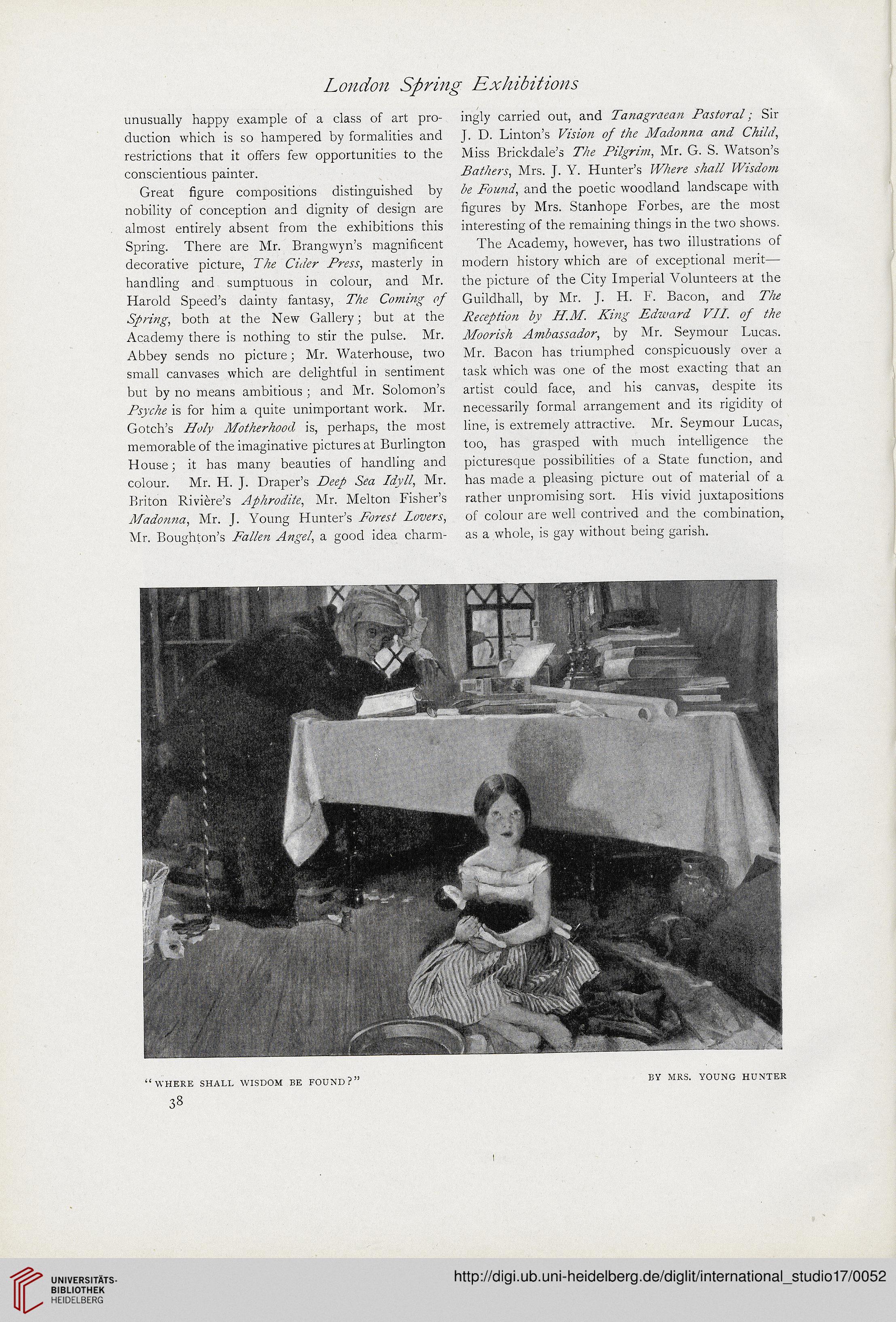London Spring Exhibitions
unusually happy example of a class of art pro-
duction which is so hampered by formalities and
restrictions that it offers few opportunities to the
conscientious painter.
Great figure compositions distinguished by
nobility of conception and dignity of design are
almost entirely absent from the exhibitions this
Spring. There are Mr. Brangwyn’s magnificent
decorative picture, The Cider Press, masterly in
handling and sumptuous in colour, and Mr.
Harold Speed’s dainty fantasy, The Coming of
Spring, both at the New Gallery; but at the
Academy there is nothing to stir the pulse. Mr.
Abbey sends no picture; Mr. Waterhouse, two
small canvases which are delightful in sentiment
but by no means ambitious ; and Mr. Solomon’s
Psyche is for him a quite unimportant work. Mr.
Gotch’s Holy Motherhood is, perhaps, the most
memorable of the imaginative pictures at Burlington
House; it has many beauties of handling and
colour. Mr. H. J. Draper’s Deep Sea Idyll, Mr.
Briton Riviere’s Aphrodite, Mr. Melton Fisher’s
Madonna, Mr. J. Young Hunter’s Forest Lovers,
Mr. Boughton’s Fallen Angel, a good idea charm-
ingly carried out, and Tanagraean Pastoral; Sir
J. D. Linton’s Vision of the Madonna and Child,
Miss Brickdale’s The Pilgrim, Mr. G. S. Watson’s
Bathers, Mrs. J. Y. Hunter’s Where shall Wisdom
be Found, and the poetic woodland landscape with
figures by Mrs. Stanhope Forbes, are the most
interesting of the remaining things in the two shows.
The Academy, however, has two illustrations of
modern history which are of exceptional merit—
the picture of the City Imperial Volunteers at the
Guildhall, by Mr. J. H. F. Bacon, and The
Reception by HM. King Edward VII. of the
Moorish Ambassador, by Mr. Seymour Lucas.
Mr. Bacon has triumphed conspicuously over a
task which was one of the most exacting that an
artist could face, and his canvas, despite its
necessarily formal arrangement and its rigidity of
line, is extremely attractive. Mr. Seymour Lucas,
too, has grasped with much intelligence the
picturesque possibilities of a State function, and
has made a pleasing picture out of material of a
rather unpromising sort. His vivid juxtapositions
of colour are well contrived and the combination,
as a whole, is gay without being garish.
i
unusually happy example of a class of art pro-
duction which is so hampered by formalities and
restrictions that it offers few opportunities to the
conscientious painter.
Great figure compositions distinguished by
nobility of conception and dignity of design are
almost entirely absent from the exhibitions this
Spring. There are Mr. Brangwyn’s magnificent
decorative picture, The Cider Press, masterly in
handling and sumptuous in colour, and Mr.
Harold Speed’s dainty fantasy, The Coming of
Spring, both at the New Gallery; but at the
Academy there is nothing to stir the pulse. Mr.
Abbey sends no picture; Mr. Waterhouse, two
small canvases which are delightful in sentiment
but by no means ambitious ; and Mr. Solomon’s
Psyche is for him a quite unimportant work. Mr.
Gotch’s Holy Motherhood is, perhaps, the most
memorable of the imaginative pictures at Burlington
House; it has many beauties of handling and
colour. Mr. H. J. Draper’s Deep Sea Idyll, Mr.
Briton Riviere’s Aphrodite, Mr. Melton Fisher’s
Madonna, Mr. J. Young Hunter’s Forest Lovers,
Mr. Boughton’s Fallen Angel, a good idea charm-
ingly carried out, and Tanagraean Pastoral; Sir
J. D. Linton’s Vision of the Madonna and Child,
Miss Brickdale’s The Pilgrim, Mr. G. S. Watson’s
Bathers, Mrs. J. Y. Hunter’s Where shall Wisdom
be Found, and the poetic woodland landscape with
figures by Mrs. Stanhope Forbes, are the most
interesting of the remaining things in the two shows.
The Academy, however, has two illustrations of
modern history which are of exceptional merit—
the picture of the City Imperial Volunteers at the
Guildhall, by Mr. J. H. F. Bacon, and The
Reception by HM. King Edward VII. of the
Moorish Ambassador, by Mr. Seymour Lucas.
Mr. Bacon has triumphed conspicuously over a
task which was one of the most exacting that an
artist could face, and his canvas, despite its
necessarily formal arrangement and its rigidity of
line, is extremely attractive. Mr. Seymour Lucas,
too, has grasped with much intelligence the
picturesque possibilities of a State function, and
has made a pleasing picture out of material of a
rather unpromising sort. His vivid juxtapositions
of colour are well contrived and the combination,
as a whole, is gay without being garish.
i




